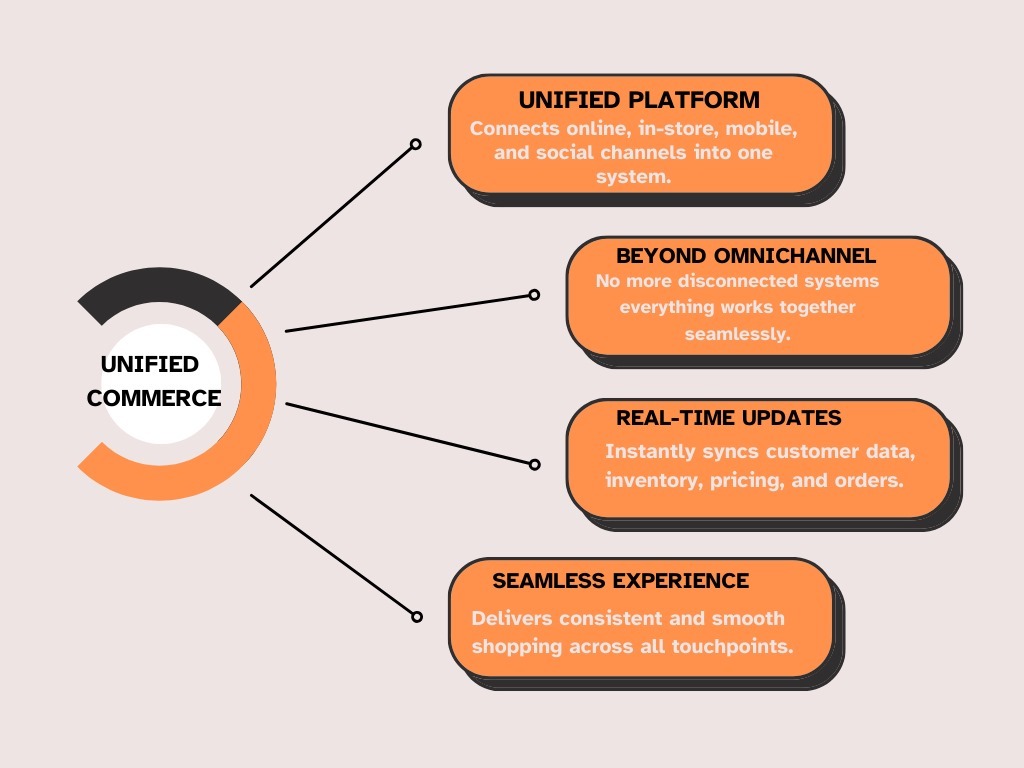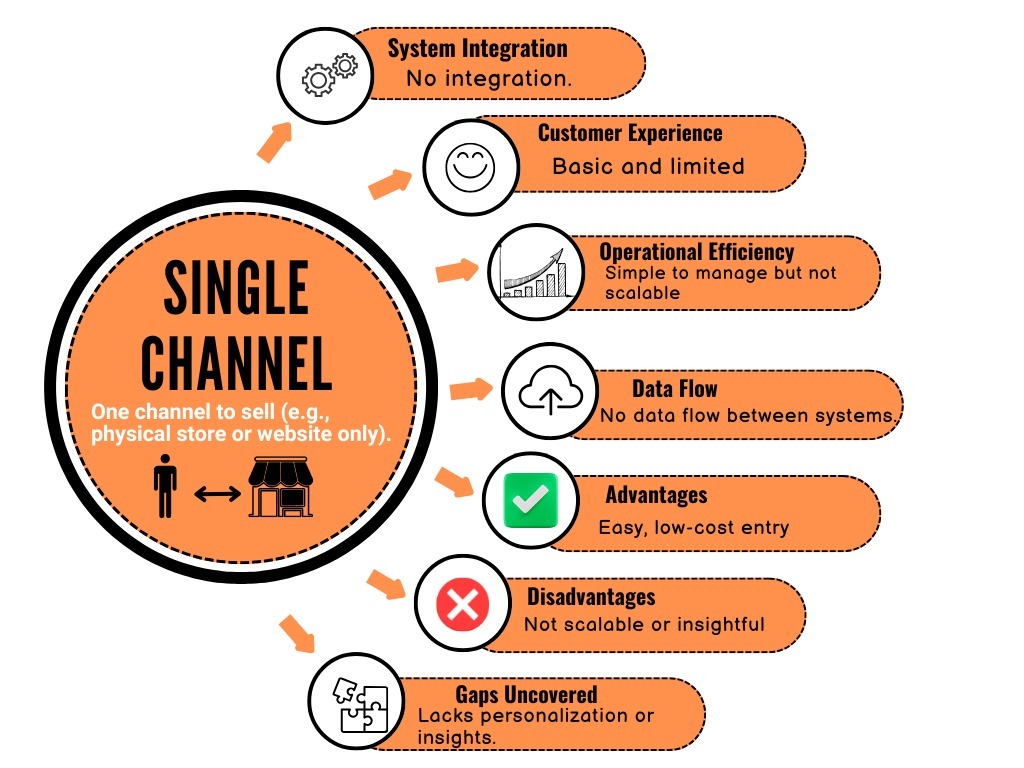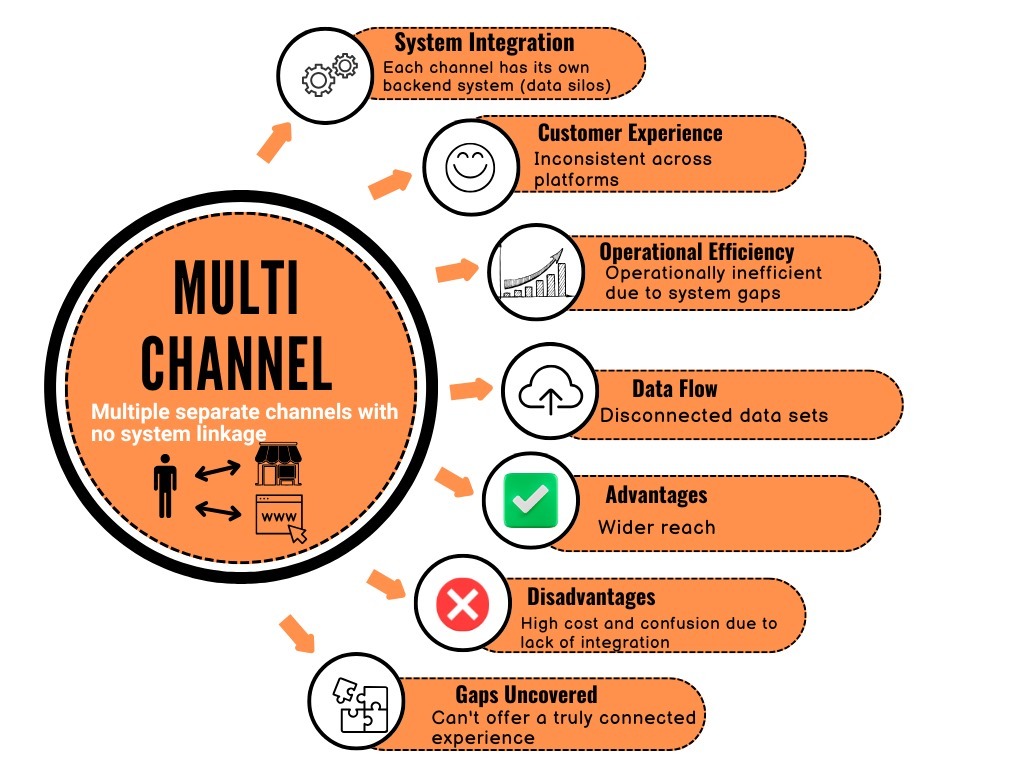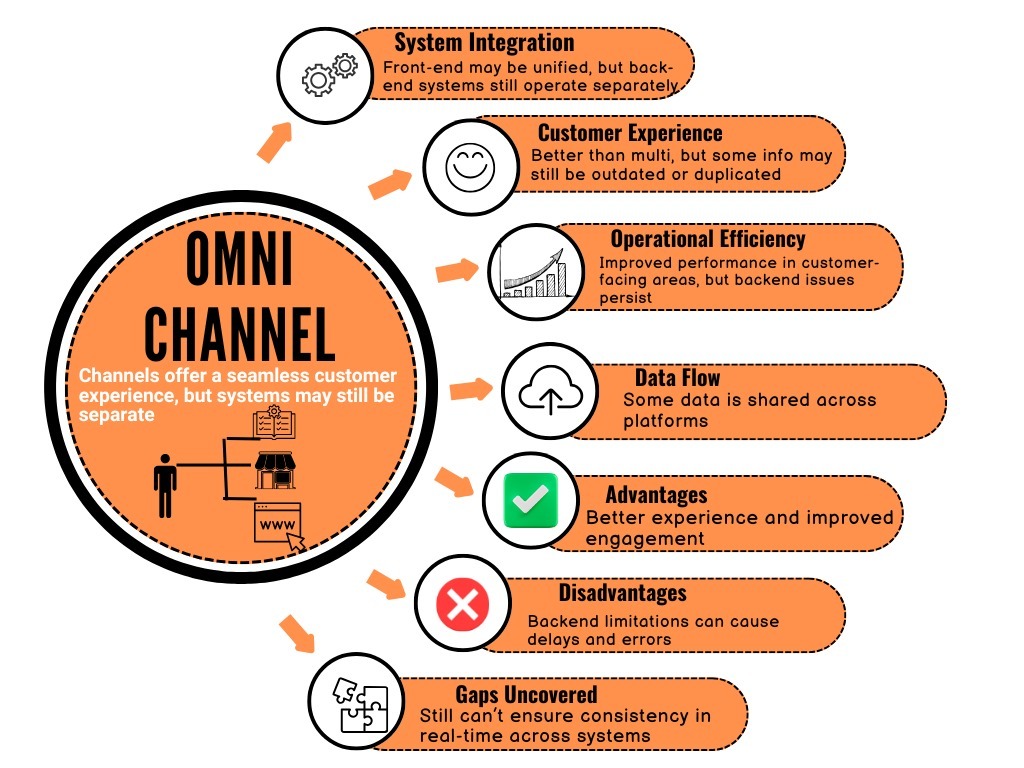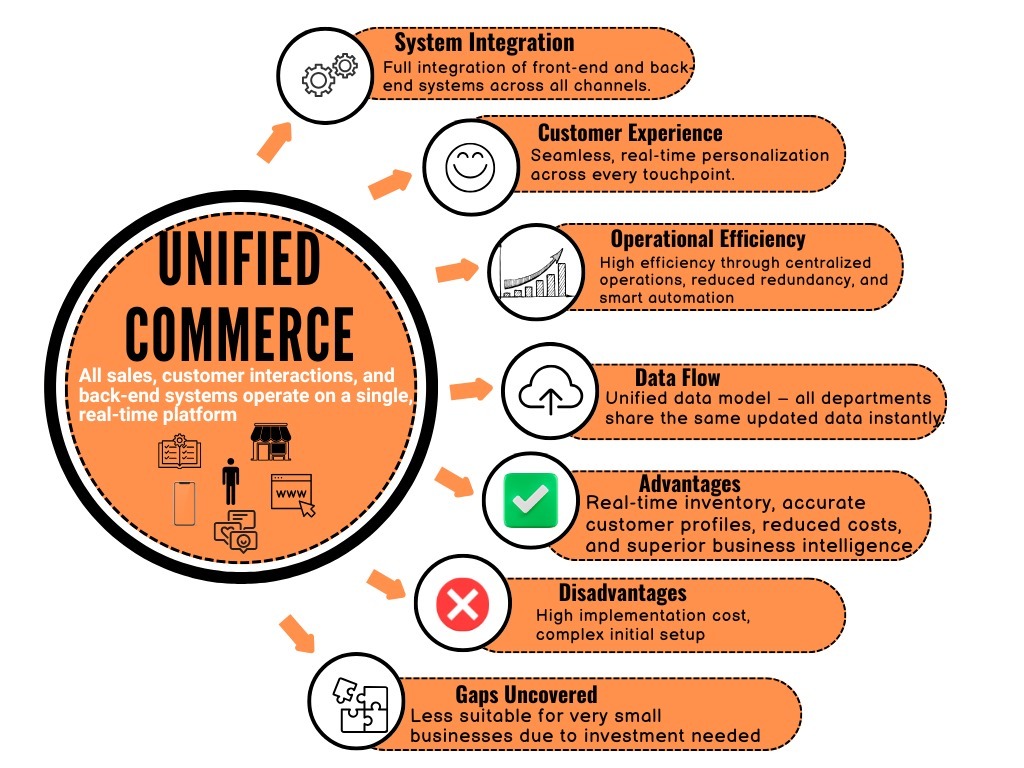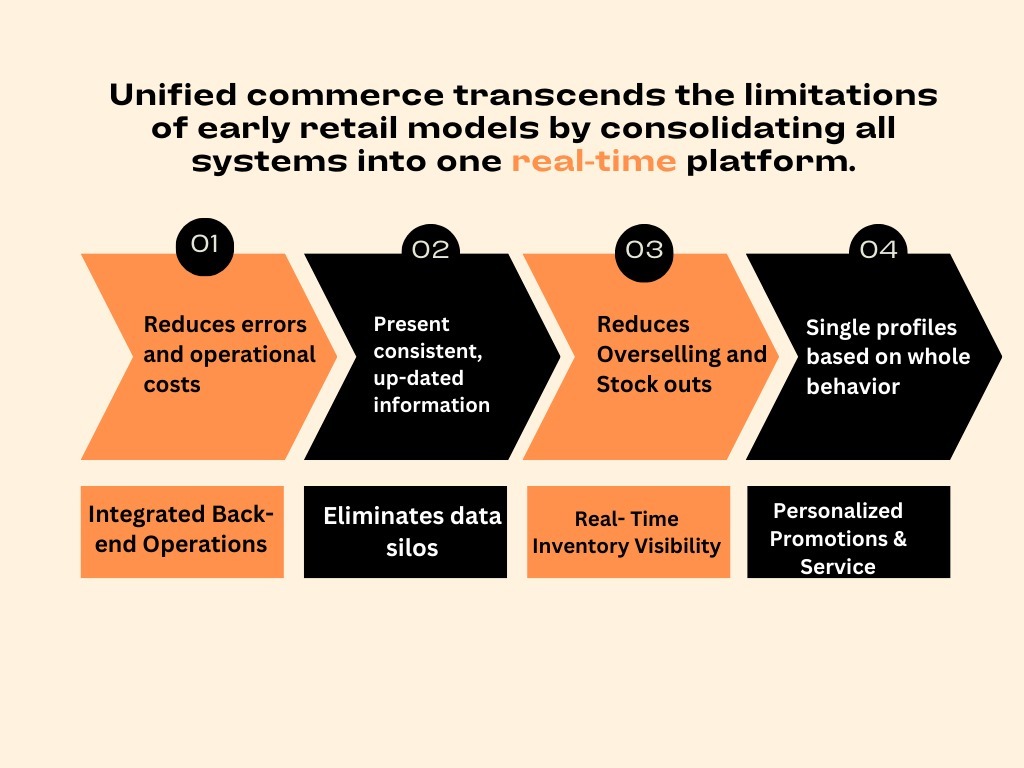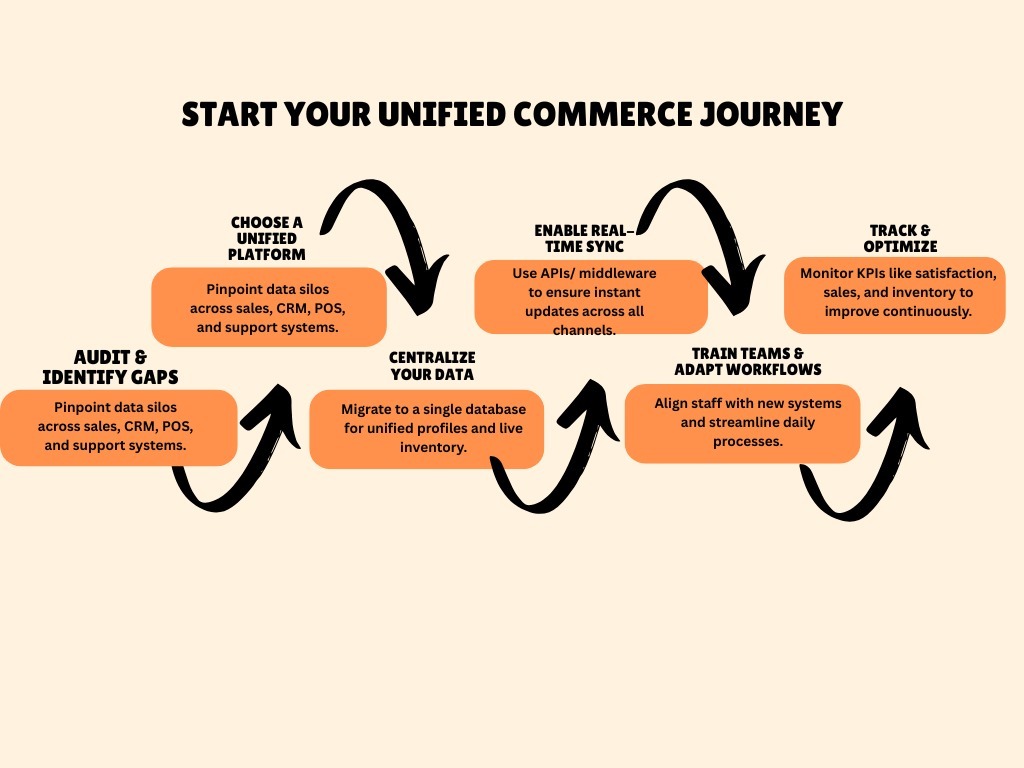Unified Commerce - The Answer to Retail's Biggest Modern Challenge

Share with others
Retail Systems Are Falling Behind And So Are Your Customers..
Imagine a customer who adds a pair of shoes to their cart through a mobile app, tries them on in-store, and completes the purchase later at home on their laptop, all with real-time inventory updates, saved preferences, and consistent pricing across every channel.
Customers are looking for brands that are seamlessly integrating with their lifestyle, the ease and effortlessness of accessing products and services when and how they want, they expect speed, personalization, and consistency across every channel. Whether they’re shopping on your website, visiting your store, or browsing your brand on social media, consumers expect a seamless experience across all channels. More seamlessly that experience is to the customer, when every customer is making a buying decision, the brand will be there to “catch” when they fall.
Disconnected channels, siloed data, and fragmented operations create major challenges for retailers leading to abandoned carts, stockouts, mismatched prices, and lost customer loyalty. Unified commerce addresses these problems by integrating all systems and channels into a single, seamless platform.
Major e-commerce technology vendors are building up to the buzzword “Unified Commerce” a holistic approach that integrates all channels, systems, and customer interactions into one single source of truth ensuring every part of your business works from the same real-time data.
Leading e-commerce technology providers are increasingly aligning with the principles of Unified Commerce, a holistic model that seamlessly integrates all sales channels, backend systems, and customer interactions. At its core, it relies on a single source of truth, enabling real-time data sharing across the business to ensure consistency, accuracy, and a connected customer experience. We will take an objective look at this proposed solution.
Evolution of Commerce, From Traditional to Unified Commerce
Before getting to Unified Commerce we need to understand the evolution of commerce. Need to bring the evolution paragraphs here.
Commerce has evolved significantly over time, starting with Traditional Commerce, where buying and selling occurred in physical stores through manual processes. The rise of the internet introduced E-Commerce, enabling online shopping with global reach and digital transactions. Businesses then adopted Multi Channel Commerce, selling through multiple channels like websites, apps, and stores but each operated separately.
To improve customer experience, Omnichannel Commerce emerged, integrating channels (like websites, apps, and stores) to offer smoother transitions. However, backend systems often remained disconnected. Finally, Unified Commerce brought all systems including sales, inventory, customer data, and payments onto one platform (like Shopify or VTEX), delivering real-time, personalized, and seamless experiences across every channel.
What is Unified Commerce?
Unified commerce integrates all sales channels online, in-store, mobile, and B2B into a single platform. This approach ensures a seamless shopping experience for customers and streamlined operations for businesses. Shopify highlights unified commerce as a real-time, centralized system that connects all sales channels, operations, and customer interactions, eliminating disconnected systems to deliver consistent, personalized experiences and greater efficiency.
Unified commerce is a strategy that integrates all sales channels, systems, and customer interactions into a single real-time platform. Unlike omnichannel models that connect platforms separately, unified commerce centralizes them, eliminating data silos. This allows businesses to deliver consistent, personalized experiences across physical stores, online shops, mobile apps, and more while improving operational efficiency and real-time visibility across the entire commerce ecosystem
Unified commerce is a modern retail strategy that connects all sales channels such as, online, in-store, mobile,B2B and social into a single centralized platform powered by systems like Shopify or VTEX. Unlike omnichannel systems that often run on disconnected back-end systems technologies, unified commerce ensures that customer data, inventory, pricing, and orders are updated in real time across all touchpoints.
From a business perspective, unified commerce enhances operational efficiency by reducing technical debt, fewer system integrations and less technology context switching streamline workflows and reduce maintenance overhead. It also improves inventory accuracy through real-time tracking across all channels, and supports smarter decision-making with centralized, reliable data.Together, these benefits lead to faster operations, better resource management, and a more agile business model.
Faster and more accurate order processing means customers receive their orders promptly and correctly. This reduces frustration from delays or incorrect shipments, enhances trust in the brand, and improves overall satisfaction with the shopping experience. Streamlined order workflows reduce manual effort, minimize processing errors, and cut down on operational costs. It enables businesses to fulfill more orders efficiently, lowers return rates due to mistakes, and strengthens supply chain reliability and ultimately increasing profitability.
From a customer perspective, it means a seamless experience, consistent pricing, personalized offers, and the ability to sFrom a customer perspective,it provides seamless transition capabilities, allowing shoppers to start their journey on one channel and effortlessly complete it on another, with consistent pricing and personalized offers throughout.
From the customer’s perspective, unified commerce delivers a frictionless, connected shopping experience seamless, integrated shopping journey across every channel. Whether starting on a mobile app, browsing in-store, or checking out online, shoppers enjoy seamless transitions without repetitive data entry or interruptions data re-entry or disruption. Consistent pricing, real-time product availability, and cohesive promotions ensure transparency and clarity at every touchpoint. Personalized recommendations and loyalty rewards are delivered contextually, based on a single customer profile, enhancing relevance and satisfaction. Ultimately, unified commerce empowers customers with convenience, consistency, and control, creating a streamlined journey that meets the expectations of modern, digitally savvy buyers.There can be a lot more benefits and we need to bring everything here.
When it comes to data consistency, data can be divided into 2 distinct categories. Direct data and metadata driven dynamic data. It creates unnecessary challenges if we are using disparate systems to tackle different channels and wants to create a purely seamless experience to the customer during channel transitions. Different systems expect inputs(medatata) in specific ways to that platform to emit an expected output consistent across multiple channels. A closet example would be a discount coupon that triggered the user to engage in the buying flow on one channel and make a transition to another channel where the user is actually making the purchase.
The Evolution to Unified Commerce- From Fragmented Retail to a Seamless Customer Experience
Retail has come a long way from the days of single physical stores to today’s advanced digital shopping. At first,Started from traditional selling and then retailers sold through multiple channels like websites and stores, but these systems weren’t connected, leading to confusing, inconsistent experiences for customers.
Then came omnichannel, where all touchpoints (web, mobile, social, in-store) worked together to improve the experience. However, while omnichannel improved the customer experience by creating more touchpoints, it still relied on separate systems for each channel.
Now, unified commerce is changing everything. Unified commerce is emerging as a solution to the problems occurring in omnichannel commerce. It connects all systems and channels in one place, providing a single source of truth where inventory, customer data, orders, and services are always up to date. For customers, this means a smooth, personalized experience, same products, same prices, and same service, wherever and however you shop. For customers, unified commerce ensures consistency across all touchpoints by offering the same products, prices, and services, regardless of the channel or location.
While inventory and orders are relatively straightforward, personalized offers, loyalty rewards, and dynamic content often rely on real-time user data and behavior, making them harder to maintain consistently across platforms. These discrepancies can disrupt the customer experience during channel transitions. To fully leverage the power of unified commerce, organizations must ensure that even these complex, metadata-driven elements are integrated into the single source of truth.
1. Single-Channel Retail
Retailers sold mainly through one channel, like a physical store, offering simple, personal service. Early online efforts, such as selling on early digital marketplaces like eBay, existed but lacked integration, limiting reach and real-time data access.
2. Multi-Channel Retail
Sells on multiple channels (store, website, app) but each operates separately. Greater audience reach, diversified revenue streams.
However, disconnected systems lead to inconsistent pricing across channels, siloed customer and sales data, and frequent stock mismatches. These issues create a fragmented customer experience, causing frustration, loss of trust, increased cart abandonment, and ultimately, lower customer retention rates.
3. Omnichannel
Connects customer-facing experiences, such as allowing customers to browse products online and pick them up in-store, creating better continuity and convenience across channels. (e.g., browse online, pick up in store). Better continuity and convenience across channels.
Using disparate systems across channels often leads to fragmented experiences, especially when users switch platforms mid-journey for example, receiving a discount code via email and trying to redeem it through a mobile app.
• Backend systems (such as CRM, inventory, and POS) are often not integrated in real time. This causes several issues
• Delays in order processing and fulfillment
• Irrelevant promotions being sent to customers
• Stock errors, such as selling out-of-stock item
Collectively, these challenges erode customer trust and diminish long-term loyalty. In omnichannel environments, data consistency hinges on managing two types of data: direct data (like user inputs) and metadata-driven dynamic data (such as discount codes or personalized content). To avoid such breakdowns, systems must share a common understanding of data and metadata. This ensures a seamless experience, where user actions and context are preserved across channels.
Key benefits
• Seamless cross-channel transitions
• Consistent personalization and messaging
• More accurate analytics and customer insights
• Operational efficiency and easier scalability
• Reduced technical errors
Example of Loyalty points syncing across store and app, content personalization based on browsing history, or consistent customer support across chat and email.
4. Unified Commerce
Unified Commerce Combines all channels & systems (sales, CRM, inventory, ERP) into one platform. Real-time updates, full customer profiles, seamless experience everywhere. Boosts efficiency, inventory accuracy, personalization, and satisfaction. Requires planning but long-term gains outweigh initial costs.How Unified Commerce Solves the Limitations of Previous Retail Models.
How Unified Commerce Solves the Limitations of Previous Retail Models
Unified commerce advances beyond earlier retail models, such as multichannel and omnichannel, by consolidating all systems, data, and customer interactions into a single real-time platform.
While omnichannel strategies improved cross-channel integration, they often still relied on fragmented systems and duplicate data structures. Unified commerce eliminates these limitations by giving every department from marketing to sales to fulfillment access to a consistent, real-time view of the customer and operations.
This enables personalized promotions triggered by live behaviors, synchronized pricing across physical and digital channels, and seamless fulfillment options like buy-online-pick-up-in-store (BOPIS) or ship-from-store. It reduces technical debt by minimizing third-party integrations and "technology context switching," streamlining workflows and boosting operational efficiency.
Businesses also gain centralized analytics for faster decision-making, improved fraud prevention, and the agility to scale into new channels or regions without disrupting core infrastructure. In short, unified commerce doesn't just solve operational problems, it empowers a smarter, more customer-centric business model.
Functional Capabilities of Unified Commerce Systems
Unified commerce systems go beyond integration and they offer a real-time, centralized solution that unifies data, systems, and customer touchpoints.
-
Centralized Data Management - A single, unified database ensures that customer, product, inventory, and order data are consistent and accessible across all departments and sales channels.
-
Real-Time Synchronization- Inventory, pricing, and order updates are reflected instantly across online and offline systems, enabling seamless experiences like Buy Online, Pick Up In Store (BOPIS).
-
Seamless Cross-Channel Journeys- Unified customer profiles track interactions across all channels, enabling personalized experiences such as synchronized carts and targeted offers.
-
Integrated Order & Inventory Management - Get real-time visibility into stock across warehouses, stores, and fulfillment centers. Prevent overselling, optimize logistics, and manage returns smoothly.
-
Unified POS and Backend Systems - Synchronize your Point of Sale, CRM, ERP, and eCommerce into one streamlined workflow for operational efficiency and better customer service.
-
Advanced Analytics and Reporting - Real-time dashboards offer actionable insights into customer behavior, sales performance, inventory trends, and marketing ROI.
-
Flexible API Architecture - Allows easy integration with third-party tools and future technologies, ensuring your system stays scalable and adaptable.
-
Enhanced Security and Compliance - Protect customer data with centralized controls, GDPR and PCI-DSS compliance, and enterprise-grade security frameworks.
Non functional capability expectations for Unified commerce systems
• Systems need to withstand significantly higher traffic - which require underlying service and infrastructure capabilities.
• May need to support multiple API protocols to optimize for different digital experiences (MQTT, REST, gRPC, GraphQL) while maintaining underlying information consistency.
• High availability for operational resilience - If the central system goes down, it can debilitate the entire customer facing operations of the organization, ie, website, POS, Punchout, Mobile Apps, IoT solution everything will see blackouts or degraded services. It's highly important to consider these systems as mission critical systems
Retail Models Compared: Unified Commerce Stands Out, But It's Not the Only Option
1. Single-Channel Specialization
Niche and luxury brands may thrive in a single-channel environment, offering highly curated experiences. However, they lack reach, scalability, and adaptability in today’s fast-moving digital economy.
2. Multichannel Improvements
A multichannel strategy facilitates greater scalability and broader market coverage by integrating diverse platforms. This approach enhances customer acquisition by supporting multiple touchpoints and expanding access points, thereby increasing the overall reach and engagement with a wider consumer base.
3. Omnichannel Advancements
Some retailers are still enhancing traditional omnichannel setups coordinating online and offline, but these models often rely on disconnected systems, leading to challenges such as limited real-time data, operational complexity, inconsistent customer experiences, and inefficient inventory management.
4. Unified Commerce Solutions
Unified commerce consolidates all systems and touchpoints into one platform. It enables real-time visibility, operational efficiency, and consistent experiences, making it the most agile and future-proof model for modern retail.
What Are the Primary Benefits of an Omnichannel Strategy, and How Does Unified Commerce Reinforce Them?
Centralized Operations
• Omnichannel platforms empower retailers to manage inventory, pricing, and promotions in a single dashboard, ensuring that a customer sees the same product availability and offers whether they shop in-store, online, or via mobile.
• Unified Commerce can similarly consolidate these operations into one system, but it builds on omnichannel by adding deeper real-time synchronization across all departments.
Consistent Customer Data
• Omnichannel architectures collect and harmonize customer interactions from diverse touchpoints web visits, in-store purchases, and mobile engagement to produce a comprehensive view of shopper behaviour.
• Unified Commerce takes this a step further by storing all interactions in a single database, ensuring the same rich data is immediately available to every team.
Seamless Cross-Channel Journeys
• With omnichannel, a shopper can add items to a cart on their phone, ask a question via live chat on the website, then pick up the purchase in-store each handoff feels natural and uninterrupted.
• Unified Commerce complements this by running those journeys on one shared engine, helping avoid any lag in order status or fulfillment updates.
Integrated Customer Support
• Omnichannel support integrates chatbots, in app messaging, email, and call centers so that agents have full context, no matter which channel the customer originally used.
• Unified Commerce can underpin this approach with a single support backbone, making it easier to track every request and resolution in one place.
How to Start Your Unified Commerce Journey?
Audit your current systems and identify isolated tools and data silos across sales, inventory, CRM, POS, and support.
Select a unified commerce solution that integrates e-commerce, in-store POS, inventory management, customer data, and analytics.
Centralize your data infrastructure with migrate individual databases into a single system to create unified customer profiles and live inventory updates.
Enable real-time system synchronization using APIs and middleware, ensuring all channels update instantly from a single source of truth.
Train Teams & Rebuild Workflows
Monitor KPIs such as customer satisfaction, inventory turnover, and sales performance regularly to make operations even more superior.
What Competitors Are Already Gaining
Forward-thinking brands already embracing unified commerce are,
Forward-thinking brands embracing unified commerce are reducing cart abandonment by up to 30%, as customers gain confidence from real-time stock availability and trust consistent, transparent pricing during their purchase journey.
Unified commerce has helped brands boost inventory accuracy by 25–40%, minimizing backorders and lost sales. However, complete accuracy remains challenging due to external factors like supply chain variability and operational errors.
Boosting customer lifetime value through personalized, consistent engagement across every touchpoint.
Conclusion – The Strategic Importance of Unified Commerce
Customers don’t think in channels, they think in seamless, personalized experiences. If your business systems aren’t unified, your customer journey isn’t either. Unified commerce isn’t just a trend, it’s a strategic foundation for retail brands that want to stay relevant, responsive, and profitable in a fast-evolving market. Yes, transitioning to unified commerce comes with challenges, upfront investment, platform integration, and change management can seem complex. But these are temporary hurdles compared to the long-term payoff: real-time agility, improved loyalty, operational clarity, and scalable growth.
Retail Systems Are Falling Behind And So Are Your Customers..
Evolution of Commerce, From Traditional to Unified Commerce
What is Unified Commerce?
The Evolution to Unified Commerce- From Fragmented Retail to a Seamless Customer Experience
How Unified Commerce Solves the Limitations of Previous Retail Models
Functional Capabilities of Unified Commerce Systems
Non functional capability expectations for Unified commerce systems
Retail Models Compared: Unified Commerce Stands Out, But It's Not the Only Option
What Are the Primary Benefits of an Omnichannel Strategy, and How Does Unified Commerce Reinforce Them?
How to Start Your Unified Commerce Journey?
What Competitors Are Already Gaining
Conclusion – The Strategic Importance of Unified Commerce
